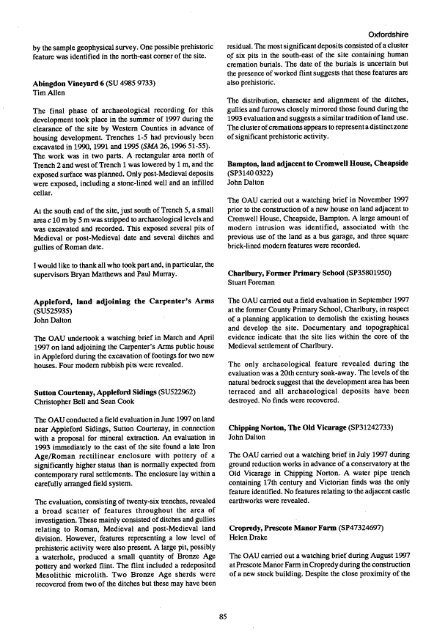CBA SMA\SMA 1998.PDF - Council for British Archaeology
CBA SMA\SMA 1998.PDF - Council for British Archaeology
CBA SMA\SMA 1998.PDF - Council for British Archaeology
You also want an ePaper? Increase the reach of your titles
YUMPU automatically turns print PDFs into web optimized ePapers that Google loves.
y the sample geophysical survey. One possible prehistoric<br />
feature was identified in the north-east corner of the site.<br />
Abingdon Vineyard 6 (SU 4985 9733)<br />
Tim Allen<br />
The final phase of archaeological recording <strong>for</strong> this<br />
development took place in the summer of 1997 during the<br />
clearance of the site by Western Counties in advance of<br />
housing development. Trenches 1-5 had previously been<br />
excavated in 1990, 1991 and 1995 (SMA 26, 1996 51-55).<br />
The work was in two parts. A rectangular area north of<br />
Trench 2 and west of Trench 1 was lowered by 1 m, and the<br />
exposed surface was planned. Only post-Medieval deposits<br />
were exposed, including a stone-lined well and an infilled<br />
cellar.<br />
At the south end of the site, just south of Trench 5, a small<br />
area c 10 m by 5 m was stripped to archaeological levels and<br />
was excavated and recorded. This exposed several pits of<br />
Medieval or post-Medieval date and several ditches and<br />
gullies of Roman date.<br />
I would like to thank all who took part and, in particular, the<br />
supervisors Bryan Matthews and Paul Murray.<br />
Apple<strong>for</strong>d, land adjoining the Carpenter's Arms<br />
(SU525935)<br />
John Dalton<br />
The OAU undertook a watching brief in March and April<br />
1997 on land adjoining the Carpenter's Anns public house<br />
in Apple<strong>for</strong>d during the excavation of footings <strong>for</strong> two new<br />
houses. Four modern rubbish pits were revealed.<br />
Sutton Courtenay, Apple<strong>for</strong>d Sidings (SU522962)<br />
Christopher Bell and Sean Cook<br />
The OAU conducted a field evaluation in June 1997 on land<br />
near Apple<strong>for</strong>d Sidings, Sutton Courtenay, in connection<br />
with a proposal <strong>for</strong> mineral extraction. An evaluation in<br />
1993 itnmediately to the east of the site found a late Iron<br />
Age/Roman rectilinear enclosure with pottery of a<br />
significantly higher status than is normally expected from<br />
contemporary rural settlements. The enclosure lay within a<br />
carefully arranged field system.<br />
The evaluation, consisting of twenty-six trenches, revealed<br />
a broad scatter of features throughout the area of<br />
investigation. These mainly consisted of ditches and gullies<br />
relating to Roman, Medieval and post-Medieval land<br />
division. However, features representing a low level of<br />
prehistoric activity were also present. A large pit, possibly<br />
a waterhole, produced a small quantity of Bronze Age<br />
pottery and worked flint. The flint included a redeposited<br />
Mesolithic microlith. Two Bronze Age sherds were<br />
recovered from two of the ditches but these may have been<br />
Ox<strong>for</strong>dshire<br />
residual. The most significant deposits consisted of a cluster<br />
of six pits in the south-east of the site containing human<br />
cremation burials. The date of the burials is uncertain but<br />
the presenc,e of worked flint suggests that these features are<br />
also prehistoric.<br />
The distribution, character and alignment of the ditches,<br />
gullies and furrows closely mirrored those found during the<br />
1993 evaluation and suggests a similar tradition of land use.<br />
The cluster of cremations appears to represent a distinct zone<br />
of significant prehistoric activity.<br />
Bampton, land adjacent to Cromwell House, Cheapside<br />
(SP3140 0322)<br />
John Dalton<br />
The OAU carried out a watching brief in November 1997<br />
prior to the construction of a new house on land adjacent to<br />
Cromwell House, Cheapside, Bampton. A large amount of<br />
modern intrusion was identified, associated with the<br />
previous use of the land as a bus garage, and three square<br />
brick-lined modern features were recorded.<br />
Charlbury, Former Primary School (SP35801950)<br />
Stuart Foreman<br />
The OAU carried out a field evaluation in September 1997<br />
at the <strong>for</strong>mer County Primary School, Charlbury, in respect<br />
of a planning application to demolish the existing houses<br />
and develop the site. Documentary and topographical<br />
evidence indicate that the site lies within the core of the<br />
Medieval settlement of Charlbury.<br />
The only archaeological feature revealed during the<br />
evaluation was a 20th century soak-away. The levels of the<br />
natural bedrock suggest that the development area has been<br />
terraced and all archaeological deposits have been<br />
destroyed. No finds were recovered.<br />
Chipping Norton, The Old Vicarage (SP31242733)<br />
John Dalton<br />
The OAU carried out a watching brief in July 1997 during<br />
ground reduction worIcs in advance of a conservatory at the<br />
Old Vicarage in Chipping Norton. A water pipe trench<br />
containing 17th century and Victorian finds was the only<br />
feature identified. No features relating to the adjacent castle<br />
earthworks were revealed.<br />
Cropredy, Prescote Manor Farm (SP47324697)<br />
Helen Drake<br />
The OAU carried out a watching brief during August 1997<br />
at Prescote Manor Farm in Cropredy during the construction<br />
of a new stock building. Despite the close proximity of the<br />
85

















